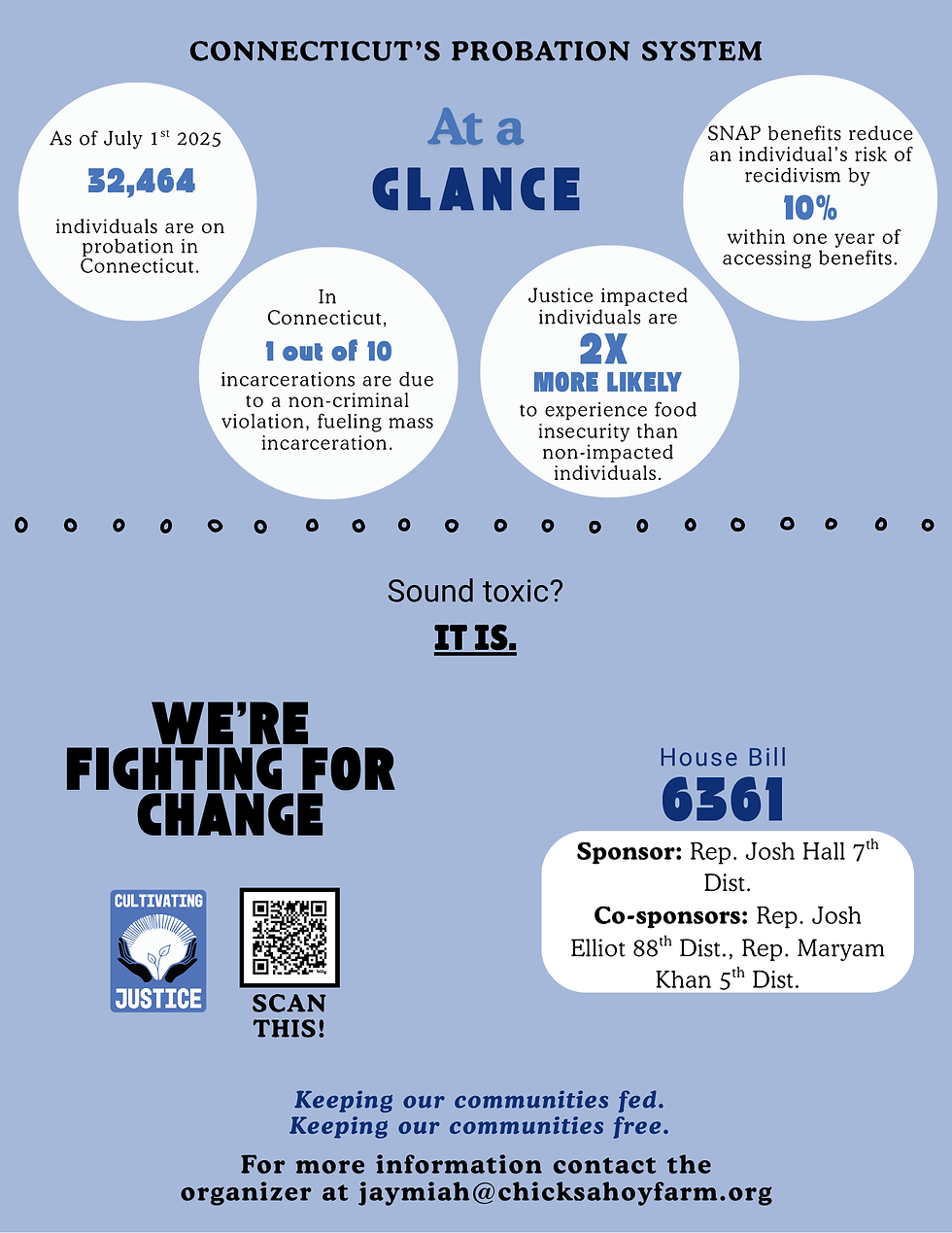Agriculture and Criminal Justice: More Connected Than You Think
- Jaymiah Herring

- Aug 16
- 3 min read
Updated: Aug 19
I was recently reading through Connecticut’s legislation about probation and § 53a-29 states that probation is a ‘conditional privilege’ for those that receive it, and it is not something that can nor should be demanded (1). Suppose probation is intended to be an alternative to incarceration or a privilege. Why then has Connecticut allowed probation to be one of the leading causes of imprisonment in the state (2) ?
In 1841, John Augustus introduced the idea of what is now recognized as probation when he convinced the courts to release a youth offender into his custody for rehabilitation instead of prison. The goal was to strike a balance between punitive measures and genuine rehabilitation, beginning with reformative approaches. The concept of probation emerged as a response to previously incarcerated individuals being recognized as having the ability to rehabilitate. With that in mind, data shows the following:
As of July 2025, there are 32,464 individuals on probation in the state of Connecticut (3)
1 in 10 incarcerations in Connecticut are due to non-criminal technical violations of supervision (4).
90% of those that have been impacted by the current criminal justice system overall are also impacted by some form of food insecurity (5).
Black and brown brothers and sisters from underserved communities are most at risk of being trapped in the criminal justice system, while according to the 2022 USDA Census of Agriculture out of 9,374 farmers in Connecticut, only 18 self-identified as Black, and 166 as Latine or Hispanic (6).
Both the agriculture and correctional system industries are billion-dollar industries; one benefits our neighbors and continues to strengthen social safety nets, while the other profits from the demise of our friends and loved ones while singing self-praises of progressive rehabilitation practices. The same communities that are most affected by food insecurity due to excessive supervision and mass incarceration are also the same communities that are underrepresented in industries that would benefit them the most. We know this because SNAP benefits have been shown to decrease the risk of recidivism by 10% within the first year of accessing benefits (7). If you think critically about it, this indicates that a percentage of crimes are committed out of poverty or a need for food stability. This is not surprising if you already know that the USDA administers SNAP. That’s because SNAP was initially intended to address the duality of food insecurity and agricultural surpluses (8). However, if the criminal justice system has impacted you, you are at risk of being denied a basic resource that has proven to keep people out of the system. I won’t continue to passively accept this reality, and that’s why I organize for community power. Cultivating Justice wants to keep our communities free, fed, and supported. We’re fighting for change.
Join our next Cultivating Justice monthly meeting on September 4th at 6:30 pm. If you are interested in Criminal Justice reform and joining our next probation reform call, please contact me at Jaymiah@chicksahoyfarm.org.

Works Cited
Works Cited
(1)Connecticut Judicial Branch. Probation in Connecticut A Guide to Resources in the Law Library, 2019, https://vvv.jud.ct.gov/lawlib/Notebooks/Pathfinders/Probation.pdf.“
(2)Prison Policy Initiative. “Fixing Connecticut's probation and parole problems.” Excessive, unjust, and expensive, 2023, https://www.prisonpolicy.org/reports/ct_supervision.html.
(3)Connecticut Judicial Branch. Judicial Branch Statistics. July 2025, https://vvv.jud.ct.gov/statistics/probation/default.htm.
(4)Prison Policy Initiative. “Fixing Connecticut's probation and parole problems.” Excessive, unjust, and expensive, 2023, https://www.prisonpolicy.org/reports/ct_supervision.html.
(5)Wang, Emily, et al. “A pilot study examining food insecurity and HIV risk behaviors among individuals recently released from prison.” 2013. National Library of Medicine, https://pubmed.ncbi.nlm.nih.gov/23514079/
(6)Census of Agriculture.” 2024. USDA, https://www.nass.usda.gov/Publications/AgCensus/2022/index.php#full_report.
(7)Yang, Crystal. Does Public Assistance Reduce Recidivism?, 2017. Havard, https://hls.harvard.edu/bibliography/does-public-assistance-reduce-recidivism/.
(8)Number Analytics. “SNAP in Agricultural Policy.” 2025, https://www.numberanalytics.com/blog/snap-agricultural-policy-guide.
that's actually pretty interesting
Really great job! Great info!
Great resources here! Thank you